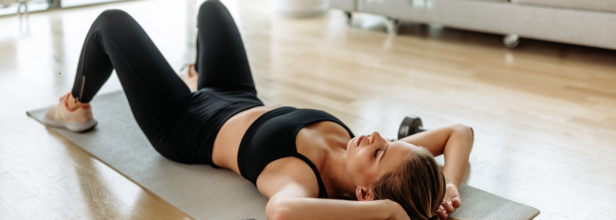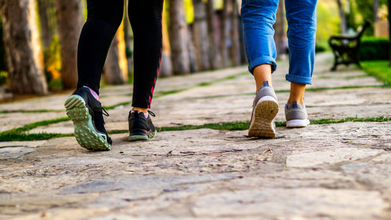- Health Conditions A-Z
- Health & Wellness
- Nutrition
- Fitness
- Health News
- Ayurveda
- Videos
- Medicine A-Z
- Parenting
These 4 Workouts Can Boost Your Sex Life

Credits: Canva
Physical fitness is important to maintain a healthy life. It helps you stay active and avoid many diseases and could be the reason for your healthy life even at an older stage of your life. But did you know that it also plays a key role in enhancing your sexual health and overall enjoyment of intimacy?
Why is exercise important for a healthier sexual life?
Studies have shown that a weak core can lead to fatigue during sexual intercourse, while poor cardiovascular health may leave you gasping for air. On the other hand, being physically fit improves endurance, flexibility, and performance, making sex more enjoyable for both partners.
A study published in The Journal Of Sexual Medicine supports the connection between exercise and better sexual health. The study titled The Association of Exercise with Both Erectile and Sexual Function in Black and White Men, show that men who exercise regularly are less likely to experience sexual dysfunction, and specific types of exercise can significantly boost sexual performance.
Here's how you can enhance your physical fitness for better sex:
Cardiovascular Fitness: Strengthening Your Heart for Endurance
Your heart health plays a vital role in sexual performance, and cardiovascular exercises are one of the best ways to improve it.
According to the American Heart Association, moderate to vigorous physical activity, coupled with a healthy diet, enhances cardiovascular health, aids weight control, and boosts your endurance in physical activities—including sex.
Research highlights the effectiveness of aerobic training in treating erectile dysfunction, emphasizing the importance of activities that elevate your heart rate.
What is the best way to get started? The easiest way for you is to start with simple exercises like walking, gradually working up to jogging, cycling, or swimming. Even a brisk hike can do wonders. The key is consistency, so choose an activity you enjoy to make it part of your routine.
Core Strength: Building Stability and Power
Your core muscles, located in your midsection, are essential for maintaining stability, balance, and power during sex. A strong core makes it easier to change positions, sustain movement, and reduce the risk of fatigue.
To build core strength, incorporate exercises like abdominal crunches, push-ups, and planks into your workout routine. For a more comprehensive approach, include side planks, which strengthen the muscles along your sides.
The best way to do a plank:
To perform a side plank, lie on your side and raise your body onto your elbow, ensuring your shoulder aligns with your elbow. Keep your hip off the floor and your body straight. As you progress, try raising yourself onto your hand for added intensity. Hold the position for several seconds on each side, breathing steadily throughout.
Balance Training: Enhancing Stability and Coordination
Balance is crucial for sexual activity, especially if you enjoy experimenting with different positions. Strengthening your balance also reduces the risk of injury and improves your overall coordination.
Exercises like mountain climbers and side lunges are excellent for improving balance. Mountain climbers target your core, arms, and shoulders while requiring coordination. Start in a push-up position and alternate bringing one knee under your chest while keeping your back straight.
Side lunges enhance balance and flexibility. Step out to the side, ensuring your knee stays over your foot, and lower your body into a lunge. Push off and return to standing, lifting your lunging leg off the ground momentarily before repeating. Perform this on both sides for a full-body workout.
Pelvic Floor Exercises: A strong foundation
Kegel exercises, which target the pelvic floor muscles, are valuable for both men and women. These muscles play a key role in urinary and colon function, and strengthening them can enhance sexual sensation and control.
To locate your pelvic floor muscles, try stopping the flow of urine midstream. Once identified, tighten these muscles for three seconds, then relax for three seconds. Perform three sets of 10 repetitions daily. While this exercise is highly beneficial, avoid doing it during urination after identifying the muscles, as it may lead to complications over time.
Running Can Fix The Damage Junk Food Causes Inside Your Brain, Study Shows Running Helps Mood

(Credit-Canva)
Researchers at University College Cork, led by Professor Yvonne Nolan, have found key biological reasons why exercise can help protect your mental health, even if you eat a typical Western diet high in fat and sugar. Your diet plays a huge role in keeping your brain healthy. Studies have shown that eating processed foods can increase your chances of developing memory and thinking issues.
However, this one habit can help you keep these issues at bay, according to researchers. The study, published in the journal Brain Medicine, shows that regular running can reduce symptoms similar to depression that are often caused by unhealthy eating. These protective effects involve changes to your gut and hormones.
Can You Eat Junk If You Exercise Enough?
To figure out how diet and exercise influence the brain, the researchers studied adult male rats for seven and a half weeks. One group of rats ate a standard healthy diet, while the other group ate a rotating "cafeteria diet" of high-fat, high-sugar foods (like ultra-processed meals).
In both diet groups, half of the animals were given a running wheel to exercise freely. This setup allowed the team to clearly see the separate and combined effects of the poor diet and physical activity on the animals' mood and brain.
The main finding was positive
Voluntary running had an antidepressant-like effect on the rats, even those eating the unhealthy cafeteria diet. This suggests that getting regular physical activity can be helpful for a person's mood, even if they struggle to completely change their eating habits.
Mood and Memory
While the unhealthy diet didn't severely harm the rats' learning or memory skills, exercise slightly improved their ability to navigate. The researchers also noticed mild anti-anxiety effects from exercise that occurred regardless of what the animals were eating.
Can Your Diet Affect Your Mental Capacity?
The high-fat, high-sugar diet severely messed up the chemicals produced in the gut (called metabolites). The researchers analyzed the contents of the caecum (a part of the large intestine) and found that the unhealthy diet affected 100 out of 175 chemical compounds they checked.
Exercise helped to restore the balance, particularly increasing three metabolites—anserine, indole-3-carboxylate, and deoxyinosine—that are known to be important for regulating mood.
The study did find one complex finding related to brain growth. In rats that ate the standard, healthy food, exercise strongly boosted adult hippocampal neurogenesis (the creation of new brain cells in the hippocampus, the area linked to memory and emotion).
However, the cafeteria diet prevented this usual exercise-induced increase in new brain cells. This suggests that while exercise helps mood regardless of diet, a poor diet might actually stop the brain from fully gaining some of the deepest, cellular-level benefits of physical activity.
Is Exercise Good For Your Mental Health?
This research has important real-world meaning. As an accompanying editorial noted, the fact that "exercise has an antidepressant-like effect in the wrong dietary context... is good news" for people who find it very hard to switch to a perfect diet.
The findings give biological proof that exercise can be an effective tool for improving mental well-being even when facing the challenges of modern, processed foods.
Future research will need to study women and explore longer periods of exercise, but this study provides a strong foundation for using lifestyle changes to support mood and brain function.
Morning vs Night Workouts: What Experts Say About the Best Time to Exercise

Credits: GEMINI
If you have made exercise a regular part of your life, you have probably wondered when the ideal time to work out really is. Should you lace up your shoes first thing in the morning, hit the gym after work, or mix it up depending on your schedule?
According to the American Heart Association, adults should aim for at least 150 minutes of moderate aerobic exercise or 75 minutes of vigorous activity each week, ideally split across several days. Adding resistance or strength training three times a week can provide even greater benefits. But what do fitness experts say about the best time to get moving?
Should I Work Out in the Morning or at Night?
Both morning and evening workouts come with their own advantages, but what matters most is consistency. The best workout time is simply the one that fits into your daily routine and keeps you moving regularly.
The Centers for Disease Control and Prevention (CDC) also recommends getting 150 minutes of aerobic exercise per week—activities like brisk walking, cycling, or jogging all count. It’s more effective to work out four evenings a week than to squeeze in only two early morning sessions.
Working Out in the Morning
Exercising early has a clear advantage, you can get it done before the rest of the day begins. Research also suggests that morning workouts can improve sleep patterns, regulate mood, and even support weight management.
Boosts Your Mood
Exercise releases endorphins, the body’s natural “feel-good” chemicals. Studies show that even short sessions of regular physical activity can lift your mood and lower cortisol, the stress hormone. Starting the day with lower stress levels can help you feel more focused and positive throughout the day.
Improves Sleep Quality
Morning exercisers often enjoy deeper, more restful sleep. One study found that those who worked out early tended to fall asleep faster, spend more time in deep sleep, and wake up less during the night.
May Lower Blood Pressure
Morning workouts can help stabilize blood pressure, particularly in women. Research suggests that women who exercised early in the day experienced lower post-exercise blood pressure, while men saw similar results when exercising in the afternoon.
Might Help You Lose Weight
Timing might play a role in how your body responds to exercise. One study found that people who worked out before noon lost more weight than those who exercised later in the day. Early exercisers were also more active overall, taking more daily steps. However, more research is needed to confirm these findings.
Downsides Of Morning Workout
Despite the perks, morning workouts aren’t without drawbacks:
- Higher injury risk: Your body temperature is lowest right after waking up, which means less blood flow and muscle flexibility. This can increase your risk of strains or sprains. A proper warm-up can help prevent this.
- Low energy: Exercising on an empty stomach can make you feel weak or tired. Eating a small, protein-rich snack the night before or before your workout can help.
Working Out in the Afternoon or at Night
While early workouts offer plenty of advantages, exercising later in the day has its own set of benefits that may suit your body and lifestyle better.
Benefits Of Working Out in the Afternoon or at Night
- Better sleep quality: Moderate evening workouts can promote deeper, more restorative sleep and improve mental clarity and energy levels.
- Increased strength: Muscles follow a natural circadian rhythm, peaking in strength and flexibility in the afternoon or evening. This can enhance performance and help you lift heavier or move more efficiently.
- Stress relief: Evening workouts can be an excellent way to unwind after a long day. Physical activity triggers endorphins that improve mood and reduce tension.
- Social motivation: Friends and family are often more available later in the day, making evening workouts a good opportunity for shared fitness goals and accountability.
- Lower injury risk: Your body temperature is naturally higher in the evening, which helps muscles warm up faster and reduces stiffness.
Downsides Of Working Out in the Afternoon or at Night
- Sleep disruption: High-intensity exercise close to bedtime can leave you too energized to fall asleep easily. If you prefer nighttime workouts, stick to moderate activities like yoga or a brisk walk.
- Limited class options: Some gyms or studios may offer more morning classes than evening ones.
- Inconsistency: Evening schedules can get crowded with social plans or work commitments, making it harder to maintain a regular exercise routine.
How To Create a Workout Routine?
No matter the time of day, staying consistent is what truly makes the difference. Creating a set routine can help you build momentum and stick to your fitness goals long-term.
Morning and evening workouts both offer unique benefits and a few drawbacks. Some studies suggest morning exercise may deliver slightly better results overall, but the best time to work out is the time that fits your life. What counts is showing up for yourself and keeping the habit steady.
Long Walks Vs Several Short Walks? Study Reveals Which One Is Better For Your Health

(Credit-Canva)
Walking is said to be one of the best exercises. Not only is it an easy and accessible exercise, but it can be done anywhere and also does not need a lot of equipment. Many people aim for 10,000 steps a day as a sign of good health. But should you take one long walk, or multiple short ones? A new study has answered this question.
New research suggests that a single, longer walk each day is better for your heart than breaking up your steps into many short strolls, especially if you don't exercise regularly.
The study, published in Annals of Internal Medicine, found that walking for at least 15 minutes without stopping is ideal. This longer, steady pace, which is about 1,500 continuous steps gives your heart a much better workout.
Longer Vs Shorter Walks: Which is Better?
Researchers tracked the walking habits of over 33,500 adults in the UK who walked less than 8,000 steps a day. After tracking their health for eight years, the findings were clear:
Lower Heart Risk
People who consistently walked in longer, uninterrupted stretches had a lower risk of heart problems compared to those who only took short, quick bursts of steps.
Why Are Longer Walks Better For Health?
Even among the least active group (those walking under 5,000 steps daily), taking longer walks made a major difference. Their risk of heart disease and early death dropped significantly.
The researchers explain that most people focus only on the number of steps they take, but not the patterns. They suggests that even inactive people can boost heart health by changing their habits to walk for at least 10–15 minutes at a time.
Should People Focus More On How They Walk Or How Much?
Many people aim for 10,000 steps a day, but that number actually came from an old pedometer advertisement, not science. While experts agree more steps are generally good, this study emphasizes that how you walk matters more than just the total step count.
The researchers suggest that simple changes, like setting aside time specifically for a long walk, could make a big impact on heart health.
The NHS still recommends getting 150 minutes of moderate activity like brisk walking, each week, and ideally it should be spread out. For older adults, moving every day, even with light activity around the house, is key.
It's important to know that while the study shows a strong link between longer walks and better health, it doesn't definitively prove that walking directly causes the improvement.
However, health experts agree exercise is vital. They explain that you might find it hard at first, but it will get easier as your body adjusts. Even small improvements contribute to a healthy heart.
What Are Some Safety Tips for Walkers?
While walking is generally a safe activity, accidents can happen, especially if you like to walk alone. To stay safe while walking,
Be Visible
Wear bright, reflective clothing or carry a flashlight after dark or in dim light so drivers and others can easily spot you.
Stay Alert
Focus on your immediate surroundings; avoid distractions like your phone or headphones to always know what's happening around you, especially traffic.
Use Paths
Walk or bike only on marked paths, lanes, or sidewalks, and cross streets at designated crosswalks where vehicles are expecting pedestrians.
© 2024 Bennett, Coleman & Company Limited

